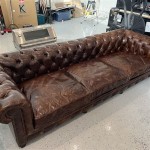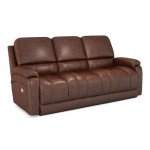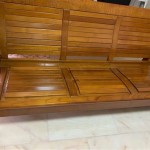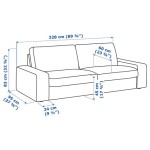Sofa White Fabric: A Comprehensive Guide
White fabric sofas represent a timeless choice for interior design, offering a clean, elegant aesthetic that can brighten any living space. However, selecting and maintaining a white fabric sofa requires careful consideration of various factors, from fabric type and construction to cleaning and upkeep. This article explores the key aspects of white fabric sofas, providing a comprehensive guide for consumers.
Fabric Types and Their Properties: Several fabric types are commonly used for white sofas, each with its own unique properties and characteristics. Understanding these differences is crucial for making an informed decision based on lifestyle and preferences.
Linen: Linen is a natural fiber known for its breathability and durability. It offers a relaxed, slightly textured appearance that adds a touch of casual elegance. However, linen can wrinkle easily and may require more frequent ironing to maintain a crisp look. It is also more susceptible to staining than synthetic fabrics.
Cotton: Cotton is another natural fiber that is soft and comfortable. It's relatively inexpensive and comes in various weaves, offering a range of textures and durability levels. However, cotton can be prone to staining and fading, making it less ideal for high-traffic areas.
Polyester: Polyester is a synthetic fabric known for its durability, wrinkle resistance, and stain resistance. It’s often blended with other fibers like cotton to enhance comfort and breathability. Polyester is a good option for families with children or pets due to its easy maintenance.
Microfiber: Microfiber is a synthetic fabric made from ultra-fine polyester fibers. It’s exceptionally soft, durable, and stain-resistant. Microfiber is also relatively easy to clean, making it a popular choice for busy households.
Velvet: Velvet adds a touch of luxury and sophistication to any living room. While visually appealing, velvet requires more delicate care and is more prone to showing marks and wear. It's best suited for low-traffic areas and formal settings.
Leather: While not a fabric, white leather sofas offer a distinct aesthetic and are often considered alongside white fabric options. Leather is durable and easy to clean, but it can be more expensive than fabric alternatives.
Construction and Durability: The construction of a sofa significantly impacts its durability and longevity. Factors like frame material, joinery techniques, and cushion filling contribute to the overall quality and comfort of the sofa.
Frame: Hardwood frames, such as kiln-dried oak or maple, are generally considered the most durable. Avoid frames made from softwoods like pine or particleboard, as they are more likely to warp or break over time.
Joints: Look for sofas with reinforced joints, such as dowelled, corner blocked, and glued construction. These techniques enhance the structural integrity of the frame and prevent loosening over time.
Cushion Filling: High-density foam cushions provide better support and maintain their shape longer than low-density foam. Down-filled cushions offer a luxurious feel but require more fluffing and maintenance.
Cleaning and Maintenance: Maintaining the pristine appearance of a white fabric sofa requires regular cleaning and preventative measures.
Vacuuming: Regular vacuuming with an upholstery attachment helps remove dust, dirt, and pet hair, preventing them from embedding into the fabric.
Spot Cleaning: Address spills and stains immediately to prevent them from setting. Blot the stain with a clean, white cloth, avoiding rubbing, which can spread the stain. Use a mild detergent or upholstery cleaner specifically designed for the fabric type.
Professional Cleaning: Consider professional upholstery cleaning once or twice a year to remove deep-seated dirt and maintain the fabric's brightness. Always test the cleaning solution in an inconspicuous area first to ensure it doesn’t damage the fabric.
Protective Measures: Using slipcovers or throws can help protect the sofa from spills and stains, especially in high-traffic areas. Consider applying a fabric protector spray to further enhance stain resistance.
Choosing the Right White: Not all whites are created equal. Variations in undertones can significantly impact the overall appearance of the sofa. Consider the existing color palette in the room and choose a white that complements it.
Cool Whites: Cool whites have blue or gray undertones and work well in modern and minimalist spaces. They can create a crisp, clean look.
Warm Whites: Warm whites have yellow or beige undertones and create a more inviting and cozy atmosphere. They pair well with traditional and transitional décor.
Bright White: Bright white is a pure, unadulterated white that offers a bold and contemporary look. It requires diligent maintenance to stay pristine.
Placement and Styling: The placement and styling of a white sofa can greatly influence the overall aesthetic of the room. Consider the size and shape of the room and choose a sofa that fits proportionally. Accessorize with colorful cushions and throws to add visual interest and personality.

Delilah White Fabric Sofa Living Room Sofas City Furniture

Alpha White Fabric Sofa Living Room Sofas City Furniture
25 Best White Stain Resistant Upholstery Fabrics Revitaliste Furniture Reupholstery Refinishing Restoration San Francisco Ca

Kaya White Fabric Sofa Living Room Sofas City Furniture

White Sofas Fabric Stuff

White Sofas Fabric Stuff

Grant White Fabric Sofa Living Room Sofas City Furniture
25 Best White Stain Resistant Upholstery Fabrics Revitaliste Furniture Reupholstery Refinishing Restoration San Francisco Ca

3 Seater Fabric Sofa Sofas Armchairs Originals Furniture

Comfortable Linen Sofa Charlie 230cm Originals Furniture Singapore








